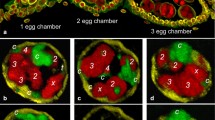Abstract
The presence of nascent RNA in chromosome region I-18C was revealed by the method of induced hybrid formation (IEH) and by use of anti-RNA: DNA antibodies. IEH signals were quantitated, and used as a measure of transcriptional activity in the region. The expansion of the I-18C region was also determined and used as an indication of local chromatin decondensation. Chironomus tentans larvae may undergo oligopause or they may develop subitaneously. It was found that the course of basal activity in I-18C differs substantially in these two modes of development. Most interestingly they also differ in activation of I-18C in response to in vitro ecdysterone treatment. Changes in hormonal responsiveness of I-18C parallel changes in the preexisting state of I-18C decondensation. Oligopause stage 5 animals, being most refractory in this respect, exhibit the most condensed I-18C chromosome region.
Similar content being viewed by others
References
Alcover A, Izquierdo M, Stollar BD, Kitagawa Y, Miranda M, Alonso C (1982) In situ immunofluorescent visualization of chromosomal transcripts in polytene chromosomes. Chromosoma 87:263–277
Arndt-Jovin DJ, Robert-Nicoud M, Baurschmidt P, Jovin TM (1985) Immunofluorescence localization of Z-DNA in chromosomes: Quantitation by scanning microphotometry and computer-assisted image analysis. J Cell Biol 101:1422–1433
Ashburner M, Chihara C, Meltzer P, Richards G (1974) Temporal control of puffing activity in polytene chromosomes. Cold Spring Harbor Symp Quant Biol 38:655–662
Beermann W (1955) Geschlechtsbestimmung und Evolution der genetischen Y-Chromosomen bei Chironomus. Biol Zentralbl 74:525–544
Busen W, Amabis M, Leoncini O, Stollar BD, Lara FJS (1982) Immunofluorescent characterization of DNA-RNA hybrids on polytene chromosomes of Trichosia pubescens (Diptera, Sciaridae). Chromosoma 87:263–277
Clever U (1966) Induction and repression of a puffin Chironomus tentans. Dev Biol 14:421–438
Clever U, Karlson P (1960) Induktion von Puff-Veränderungen in den Speicheldrüsenchromosomen von Chironomus tentans durch Ecdyson. Exp Cell Res 20:623–626
Clever U, Clever I, Storbeck I, Young NL (1973) The apparent requirement of two hormones, α- and β-ecdysone, for molting induction in insects. Dev Biol 31:47–60
Diez JL, Barettino D (1984) DNA-RNA hybrids and transcriptional activity in Chironomus polytene chromosomes. Chromosoma 90:103–110
Dworniczak B, Seidel R, Pongs O (1983) Puffing activities and binding of ecdysteroid to polytene chromosomes of Drosophila melanogaster. EMBO J 2:1323–1330
Fischer J (1974) Experimentelle Beiträge zur Oekologie von Chironomus (Diptera). I. Dormanz bei Chironomus nuditarsis und Ch. plumosus. Oecologia 16:73–95
Hertner T, Meyer B, Eppenberger HM, Mähr R (1980) The secretion proteins in Chironomus tentans salivary glands: Electrophoretic characterization and molecular weight estimation. Wilhelm Roux's Arch 189:69–72
Hertner T, Hertner-Meyer B, Sogo JM, Schläpfer G, Jäckle H, Edström JE, Lezzi M (1986) Microcloning of a long segment of a gene from the primary ecdysterone-controlled puff region I-18C of Chironomus tentans: Molecular characterization and effect of hormone on its transcription. Dev Biol 113:29–39
Ineichen H, Meyer B, Lezzi M (1983) Determination of the developmental stage of living fourth instar larvae of Chironomus tentans. Dev Biol 98:278–286
Kitagawa Y, Stollar BD (1982) Comparison of poly(A)-poly(dT) and poly(I)-poly(dC) as immunogens for the induction of antibodies to RNA-DNA hybrids. Mol Immunol 19:413–420
Laird CD, Chooi WY (1976) Morphology of transcription units in Drosophila melanogaster. Chromosoma 58:193–218
Langer-Safer PR, Levine M, Ward DC (1982) Immunological method for mapping genes on Drosophila polytene chromosomes. Proc Natl Acad Sci USA 79:4381–4385
Lezzi M (1974) In vitro effects of juvenile hormone on puffing in Chironomus salivary glands. Mol Cell Endocrinol 1:189–207
Lezzi M (1984) Heat-shock phenomena in Chironomus tentans. II. In vitro effects of heat and overheat on puffing and their reversal. Chromosoma 90:198–203
Lezzi M, Kroeger H (1966) Aufnahme von 22Na in die Zellkerne der Speicheldrüse von Chironomus thummi. Z Naturforsch 21:274–277
Lezzi M, Richards G (1989) Models for the study of ecdysteroid action. Salivary glands. In: Koolman J (ed) Ecdysone. Eine Festschrift. Thieme Verlag, Stuttgart (in press)
Lezzi M, Gatzka F, Meyer B (1984) Heat-shock phenomena in Chironomus tentans. III. Quantitative autoradiographic studies on 3H-uridine incorporation into Balbiani ring 2 and heatshock puff IV-5C. Chromosoma 90:204–210
Lezzi M, Meyer B, Mähr R (1981) Heat shock phenomena in Chironomus tentans. I. In vivo effects of heat, overheat, and quenching on salivary chromosome puffing. Chromosoma 83: 327–339
Malfoy B, Rousseau N, Leng M (1982) Interaction between antibodies to Z-form deoxyribonucleic acid and double-stranded polynucleotides. Biochemistry 21:5463–5467
Meyer B, Mähr R, Eppenberger HM, Lezzi M (1983) The activity of Balbiani rings 1 and 2 in salivary glands of Chironomus tentans larvae under different modes of development and after pilocarpine treatment. Dev Biol 98:265–277
Milgrom E, Luu Thi M, Baulieu EE (1973) Control mechanisms of steroid hormone receptors in the reproductive tract. In: Karolinska Symposia on Research Methods in Reproductive Endocrinology, pp 380–403
Pelling C (1964) Ribonukleinsäure-Synthese der Riesenchromosomen. Autoradiographische Untersuchungen an Chironomus tentans. Chromosoma 15:71–122
Valentin M, Bollenbacher WE, Gilbert LI, Kroeger H (1978) Alterations in ecdysone content during the post-embryonic development of Chironomus thummi: Correlations with chromosomal puffing. Z Naturforsch 33e: 557–560
Widmer RM, Lucchini R, Lezzi M, Meyer B, Sogo JM, Edström JE, Koller T (1984) Chromatin structure of a hyperactive secretory protein gene (in Balbiani ring 2) of Chironomus. EMBO J3:1635–1641
Wyss C (1982) Chironomus tentans epithelial cell lines sensitive to ecdysteroids, juvenile hormone, insulin and heat shock. Bxp Cell Res 139:309–319
Author information
Authors and Affiliations
Rights and permissions
About this article
Cite this article
Lezzi, M., Gatzka, F. & Robert-Nicoud, M. Developmental changes in the responsiveness to ecdysterone of chromosome region I-18C of Chironomus tentans . Chromosoma 98, 23–32 (1989). https://doi.org/10.1007/BF00293331
Issue Date:
DOI: https://doi.org/10.1007/BF00293331




